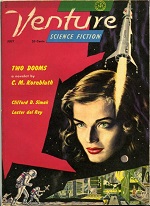Two Dooms
- by C. M. Kornbluth
- Short Story
- Science Fiction
- Adults
- Definite Time Travel
- English
- “Two Dooms” by C. M. Kornbluth, in Venture Science Fiction, July 1958.
Young Dr. Edward Royland, a physicist at Los Alamos in 1945, travels via a Hopi God Food to the early 22nd century to see what a world ruled by the Axis powers will be like—and quite possibly setting off a seemingly endless sequence of alternate WWII stories such as The Man in the High Castle, most of which, sadly, do not include time travel.
I liked Kornbluth’s description of the differential analyzer as well as the cadre of office girls solving differential equations by brute force of adding machines.
I liked Kornbluth’s description of the differential analyzer as well as the cadre of office girls solving differential equations by brute force of adding machines.
Instead of a decent differential analyzer machine they had a human sea of office girls with Burroughs’ desk calculators; the girls screamed “Banzai!” and charged on differential equations and swamped them by sheer volume; they clicked them to death with their little adding machines. Royland thought hungrily of Conant’s huge, beautiful analog differentiator up at M.I.T.; it was probably tied up by whatever the mysterious “Radiation Laboratory” there was doing. Royland suspected that the “Radiation Laboratory” had as much to do with radiation as his own “Manhattan Engineer District” had to do with Manhattan engineering. And the world was supposed to be trembling on the edge these days of a New Dispensation of Computing that would obsolete even the M.I.T. machine—tubes, relays, and binary arithmetic at blinding speed instead of the suavely turning cams and the smoothly extruding rods and the elegant scribed curves of Conant’s masterpiece. He decided that he would like it even less than he liked the little office girls clacking away, pushing lank hair from their dewed brows with undistracted hands.

Tags
(1)
- Groupings
Variants
(1)
- “Two Dooms” by C. M. Kornbluth, in Venture Science Fiction, July 1958.
